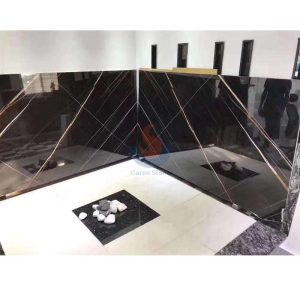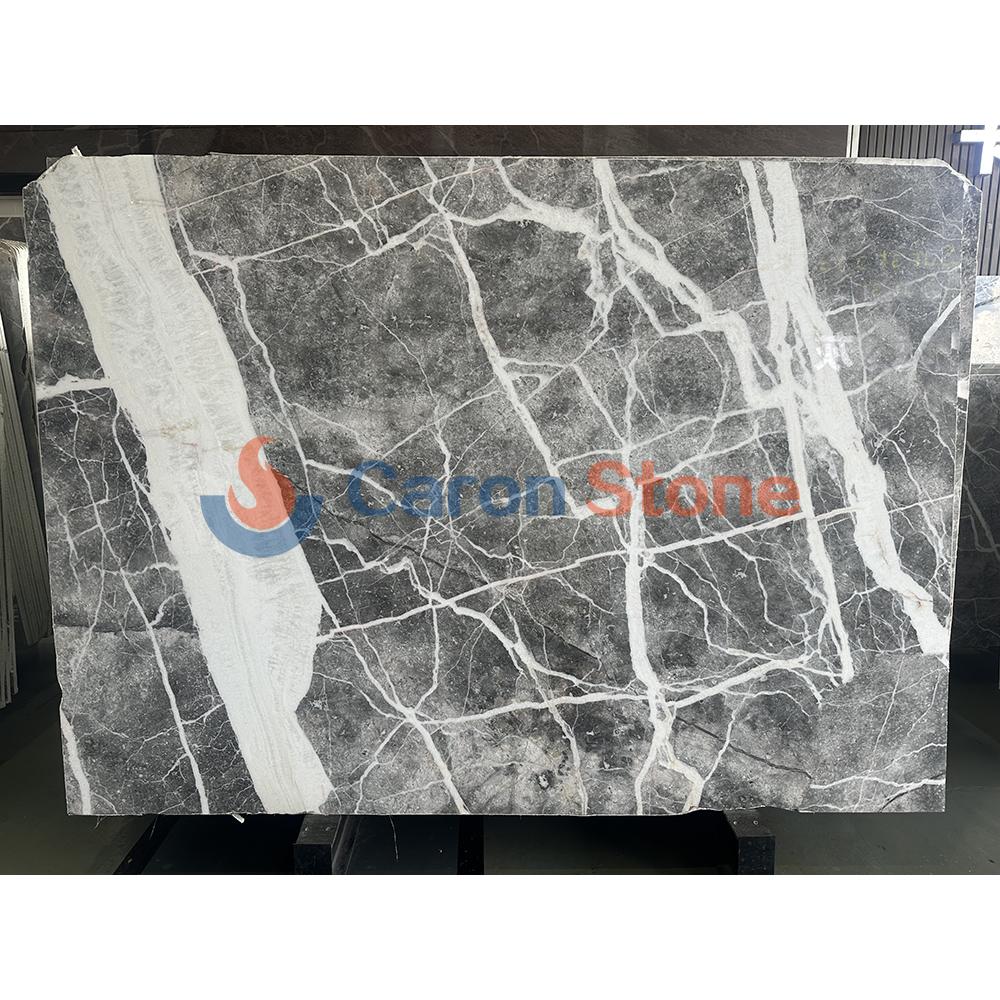When it comes to building materials, marble has always won the favor of countless designers and architects with its noble texture and unique texture. Still, the choice of building materials cannot overlook the crucial factor of fire resistance in addition to beauty. After all, no matter how gorgeous the decoration is, it needs to ensure safety in an emergency. Hence, in terms of fire resistance, how does marble stand? Does it meet the safety standards of modern buildings? This article will allow you to investigate the fire resistance of marble in depth as well as the safety criteria one should give careful thought in useful applications. Let us uncover the secret of this calm but charming stone together!

Sahara Noir Marble Slab
Analysis of the fire resistance of marble
1. Natural Stone Fire Resistance
As a natural stone, marble is mainly composed of mineral components such as calcium carbonate, magnesium, and silicates, which themselves have extremely high fire resistance. Under normal circumstances, marble will not burn at high temperatures and will not release toxic gases. Marble, thus, from the standpoint of the substance itself, is a quite safe fireproof material.
2. Marble performance in a high temperature surroundings
Marble will not burn, however under high temperature surroundings it could change physically. As the temperature rises, the calcium carbonate in marble may decompose, causing problems such as cracks, discoloration or loss of strength in the stone. Particularly when the temperature rises above 800°C, marble’s structural integrity may be seriously compromised, hence reducing its load-bearing capability. Consequently, it is quite crucial to know how well marble performs under high temperatures while deciding on a building material.
3. Marble grade of fire resistance and application
International and domestic building fire safety guidelines divide building materials into several fire resistance grades to evaluate their effectiveness in fire. Marble’s non-combustibility helps to classify it as typically A1 grade refractory material. It will so neither encourage combustion in a fire nor generate dangerous smoke. It is a very suitable building material for high fire protection requirements.
In practical applications, marble is widely used in walls, floors, countertops and other parts. Especially in some public buildings, commercial centers or high-end residences, marble is not only beautiful and generous, but also provides additional fire protection. Furthermore, marble’s smooth surface makes cleaning simple and helps to stop the spread of fire in a fire.
Safety standards and practical applications of marble
1. Overview of building fire protection standards
There are strict standards and specifications for the fire resistance of building materials around the world. Marble, for instance, is typically needed in Europe to follow the EN 13501-1 criteria, which ranks building materials into seven classes ranging from A1 to F. The highest grade, grade A1 materials indicate that they are non-flammable and do not produce poisonous vapors. The GB 8624 “Classification of Combustion Performance of Building Materials and Products” standard also unequivocally specifies the fire resistance degree of building materials including marble in China.
2. Safety certification of marble
In order to ensure that marble meets relevant fire safety standards, manufacturers usually need to conduct rigorous testing and certification on it. These tests comprise physical performance tests at high temperatures, smoke generating tests, and combustion studies. By use of these tests, manufacturers may guarantee that, upon market release, marble products can satisfy the safety requirements of different building projects.
3. How to choose the right fire-resistant marble products
When purchasing and using marble, consumers and architects should pay special attention to the product’s fire resistance level and related certification marks. High-quality marble products should be accompanied by clear fireproof certification marks to ensure that they meet the building safety standards of the country or region where they are located. Furthermore taken into account should be the choice of surrounding materials and the way the marble is installed to maximize the general fire resistance.
For example, when installing marble in the kitchen or around the fireplace, it is recommended to choose marble slabs that have been treated with fireproofing and ensure that their installation complies with fire protection regulations. Furthermore, in some settings that call for more protection, you could want to think about placing a fireproof coating on the rear of the marble to raise its general fire resistance or employing composite materials.
Examples of marble fireproof applications
Marble is widely used in various types of buildings around the world due to its excellent fireproofing performance. These are some classic application samples:
1. High-rise buildings
In high-rise buildings in modern cities, marble is often used for wall and floor decoration in the lobby. Marble not only offers magnificent visual effects but also extra fire protection for the whole building since high-rise buildings have quite high needs for fire resistance.
2. Hotels and commercial centers
In crowded places such as hotels and commercial centers, fire prevention is the primary consideration. Not only because of its durability and beauty, but also because of its safety in the case of fire, Marble is extensively employed in public areas and stairways of these places.
3. Home decoration
Marble is also a great choice for home décor, particularly in places like bathrooms and kitchens that could be heated strongly. Its fire resistance provides additional protection for family safety, while also adding a noble temperament to the living environment.

Panda White Stairs Case
As a natural building material, marble not only has unique aesthetic value, but also has superior fire resistance. Even if some physical changes could happen under very high temperatures, its safety in construction uses is still reliable. By understanding the fire resistance characteristics of marble and related safety standards, designers and consumers can better select and apply this material to make the building both beautiful and safe. While pursuing beauty, we should always keep safety in mind. After all, under the idea of guaranteeing safety, the stone’s original appeal cannot be really appreciated regardless of its beauty.





